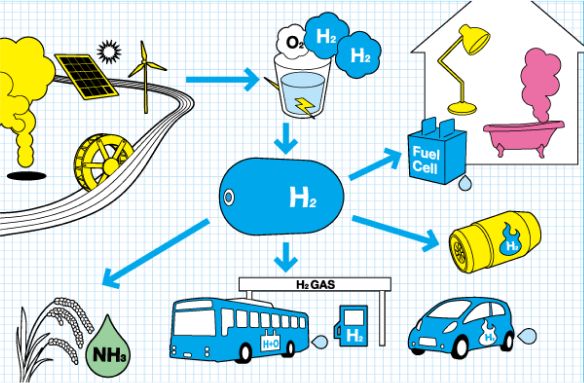
What’s Up with Hydrogen?
Hydrogen has been an excellent fuel for over 40 years, but we've had to source it from fossil fuels. Well, it turns out that H2 can be sourced from waste biomatter or renewable electricity! Let's look at this “green” hydrogen, an extremely high-powered renewable molecular fuel (think rocket ships!).
Hydrogen has been an excellent fuel for over 40 years, but we've had to source it from fossil fuels. Well, it turns out that H2 can be sourced from waste biomatter or renewable electricity! Let's look at this “green” hydrogen, an extremely high-powered renewable molecular fuel (think rocket ships!).
Outline
In the past six months, #energytwitter (yes, this is a thing!) has seen a steady string of posts about hydrogen a.k.a. H2 and its role in the clean energy economy. What’s up with that? Why H2 now? Is it something in the water? (H2O, get it? Sorry!)
Corny jokes aside, there is a very serious answer to this question. Hydrogen “could be the solution to many of the hardest parts of the transition to net-zero”, like long-distance freight, shipping and heavy industry, according to the UK’s National Grid. If so, that would make hydrogen one of the largest-scale clean energy technologies. Germany forecasts that in order to meet its decarbonization goals by 2050, the need for hydrogen (and related fuels) could be over half the size of Germany’s current electrical grid.
Now, hydrogen is not new. For over 40 years, H2 has been used in great quantities as an industrial chemical (e.g. H2 is a feedstock in the production of ammonia and methanol) and as a fuel for space exploration. As a result, a whole infrastructure is already developed to produce, store, transport and utilize H2 safely. (The days of the Hindenburg are well behind us!) Unfortunately, this hydrogen is largely sourced from fossil fuels, and is the source of around 3% of global greenhouse gas emissions today.
So what’s new about this old molecule? Well, it turns out that H2 can also be made from waste biomatter or renewable electricity. This “green” hydrogen is one of the only renewable molecular fuels, and an extremely high powered one at that (think rocket ships!). Now, propelling a spacecraft and delivering affordable clean energy solutions via H2 on planet earth are somewhat different propositions. But molecular fuels are useful for a great many applications. Like what? Check out this video that explains how fuel cells turn hydrogen into a safe (and explosion-free) transportation fuel:
While that video mainly features H2’s applications in clean transport, there’s growing interest in H2’s role in “hard to decarbonize” sectors, like heavy-duty industries that typically need extremely high temperatures to operate (or which already use hydrogen as a feedstock). The world’s first fossil-free hydrogen-powered steel plant just began operations this past week in Sweden. This single project, named HYBRIT, is projected to reduce Sweden’s carbon dioxide emissions by 10% and Finland’s by 7%. There’s also growing interest in combining H2 with CO2 sucked out of the air to produce liquid fuels. Bill Gates got into this business back in 2018, and others are following.
H2 also seems to offer an exciting solution to the problem of long-term storage in clean electricity systems. Wind and solar energy are intermittent resources: This means the sun shines sometimes and not at others, and the wind blows, well, intermittently. So we typically need a way of storing energy for use when renewable resources are not available. Batteries and demand response both help balance the intermittency problem.
But as we move toward 90%, and even 100% clean energy grids, we need longer-term storage solutions that can, for example, store up abundant solar energy in summer months in northern climates and release it for use in the darker winter months. This is where H2 is seen as offering much promise—you can make H2 from solar and wind energy when it’s abundant, store it for months, and run it through a fuel cell to produce clean electricity when you need it.

Of course, many questions remain: How much of this H2 interest is hype, or just experimental, and how much is a here-and-now investment opportunity? At a more basic level, what is “green” vs. “blue” H2? What are cutting-edge technologies for different applications? What do the best economic analyses tell us about the future of H2? And what policies and programs should governments be considering to efficiently support the development of this sector?
These questions and more have led to heavy debates on Twitter on H2’s role in the clean energy economy. The energy-savvy U.S. House candidate, Sean Caster, who’s built up quite a following based on his nerdy clean energy threads, thinks H2 is mainly hype. But is he right? A far more nuanced and well-informed set of perspectives and analyses are offered up by Gniewomir Fis, an experienced energy and finance consultant who describes himself as “somewhat obsessed with hydrogen.”
Gniewomir Fis, in fact, is so keen that people learn to think about H2 in the right way that he’s teamed up with Shawn Drost, a recent Terra.do graduate and H2 entrepreneur to offer a short course on the new H2 economy right here at Terra.do. Curious? Check out the course details and register for our free webinar on H2, where Fis and Drost will answer all your questions.
And since we started with a corny joke, we may as well end with one:
Two hydrogen atoms are walking down a street.
All of a sudden, one stops and says, “Oh my goodness I’ve lost my electron!”
The other turns to him and says, “Are you sure?”
To which the first replies, “Yeah! I’m positive!”
(Sorry, we couldn’t resist.)
More like this
So You're Ready to Step Up on Climate Action. Now What?
Folks ready to learn and do more about climate change have an array of options to get started. What are their respective pros and cons, and how does Terra.do stack up?
Our Next Cohort's Nickname Is the Manatees. Here's Why That's Special.
We've named each graduating class after animals at risk in our warming world, and we've just finished our first full lap through the alphabet.
Couldn’t We All Use More Storage?
Where are we going to put all that clean power from variable renewables like solar and wind? The world of batteries is already ramping up.

 Background
Background


